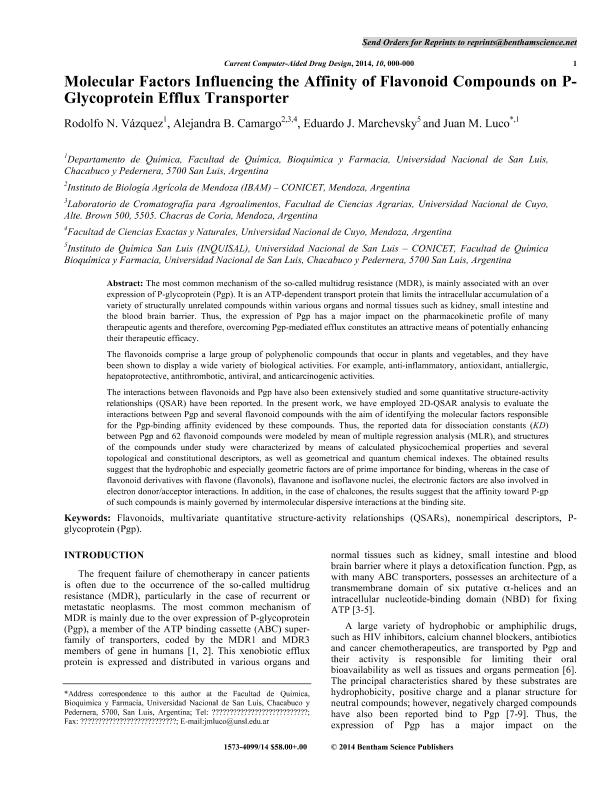Mostrar el registro sencillo del ítem
dc.contributor.author
Vázquez, Rodolfo Nieto
dc.contributor.author
Camargo, Alejandra Beatriz

dc.contributor.author
Marchevsky, Eduardo Jorge

dc.contributor.author
Luco, Juan Maria

dc.date.available
2018-01-03T20:51:59Z
dc.date.issued
2014-10
dc.identifier.citation
Luco, Juan Maria; Vázquez, Rodolfo Nieto; Camargo, Alejandra Beatriz; Marchevsky, Eduardo Jorge; Molecular Factors Influencing the Affinity of Flavonoid Compounds on PGlycoprotein Efflux Transporter; Bentham Science Publishers; Current Computer-aided Drug Design; 10; 3; 10-2014; 250-258
dc.identifier.issn
1573-4099
dc.identifier.uri
http://hdl.handle.net/11336/32218
dc.description.abstract
The most common mechanism of the so-called multidrug resistance (MDR), is mainly associated with an over expression of P-glycoprotein (Pgp). It is an ATP-dependent transport protein that limits the intracellular accumulation of a variety of structurally unrelated compounds within various organs and normal tissues such as kidney, small intestine and the blood brain barrier. Thus, the expression of Pgp has a major impact on the pharmacokinetic profile of many therapeutic agents and therefore, overcoming Pgp-mediated efflux constitutes an attractive means of potentially enhancing their therapeutic efficacy. The flavonoids comprise a large group of polyphenolic compounds that occur in plants and vegetables, and they have been shown to display a wide variety of biological activities. For example, anti-inflammatory, antioxidant, ntiallergic, hepatoprotective, antithrombotic, antiviral, and anticarcinogenic activities. The interactions between flavonoids and Pgp have also been extensively studied and some quantitative structure-activity relationships (QSAR) have been reported. In the present work, we have employed 2D-QSAR analysis to evaluate the interactions between Pgp and several flavonoid compounds with the aim of dentifying the molecular factors responsible for the Pgp-binding affinity evidenced by these compounds. Thus, the reported data for dissociation constants (KD) between Pgp and 62 flavonoid compounds were modeled by mean of multiple regression analysis (MLR), and structures of the compounds under study were characterized by means of calculated physicochemical properties and several topological and constitutional descriptors, as well as geometrical and quantum chemical indexes. The obtained results suggest that the hydrophobic and especially geometric factors are of prime importance for binding, whereas in the case of flavonoid derivatives with flavone (flavonols), flavanone and isoflavone nuclei, the electronic factors are also involved in electron donor/acceptor interactions. In addition, in the case of chalcones, the results suggest that the affinity toward P-gp of such compounds is mainly governed by intermolecular dispersive interactions at the binding site.
dc.format
application/pdf
dc.language.iso
eng
dc.publisher
Bentham Science Publishers

dc.rights
info:eu-repo/semantics/openAccess
dc.rights.uri
https://creativecommons.org/licenses/by-nc-sa/2.5/ar/
dc.subject
Flavonoids
dc.subject
Multivariate Quantitative Structure-Activity Relationships
dc.subject
Non Empirical Descriptors
dc.subject
P-Glycoprotein
dc.subject.classification
Otras Ciencias Químicas

dc.subject.classification
Ciencias Químicas

dc.subject.classification
CIENCIAS NATURALES Y EXACTAS

dc.title
Molecular Factors Influencing the Affinity of Flavonoid Compounds on PGlycoprotein Efflux Transporter
dc.type
info:eu-repo/semantics/article
dc.type
info:ar-repo/semantics/artículo
dc.type
info:eu-repo/semantics/publishedVersion
dc.date.updated
2017-12-12T18:38:46Z
dc.journal.volume
10
dc.journal.number
3
dc.journal.pagination
250-258
dc.journal.pais
Estados Unidos

dc.journal.ciudad
Oak Park
dc.description.fil
Fil: Vázquez, Rodolfo Nieto. Universidad Nacional de San Luis. Facultad de Química, Bioquímica y Farmacia; Argentina
dc.description.fil
Fil: Camargo, Alejandra Beatriz. Consejo Nacional de Investigaciones Científicas y Técnicas. Centro Científico Tecnológico Conicet - Mendoza. Instituto de Biología Agrícola de Mendoza. Universidad Nacional de Cuyo. Facultad de Ciencias Agrarias. Instituto de Biología Agrícola de Mendoza; Argentina
dc.description.fil
Fil: Marchevsky, Eduardo Jorge. Consejo Nacional de Investigaciones Científicas y Técnicas. Centro Científico Tecnológico Conicet - San Luis. Instituto de Química de San Luis. Universidad Nacional de San Luis. Facultad de Química, Bioquímica y Farmacia. Instituto de Química de San Luis; Argentina
dc.description.fil
Fil: Luco, Juan Maria. Universidad Nacional de San Luis. Facultad de Química, Bioquímica y Farmacia; Argentina
dc.journal.title
Current Computer-aided Drug Design

dc.relation.alternativeid
info:eu-repo/semantics/altIdentifier/url/http://www.eurekaselect.com/129001/article
Archivos asociados
